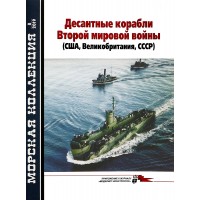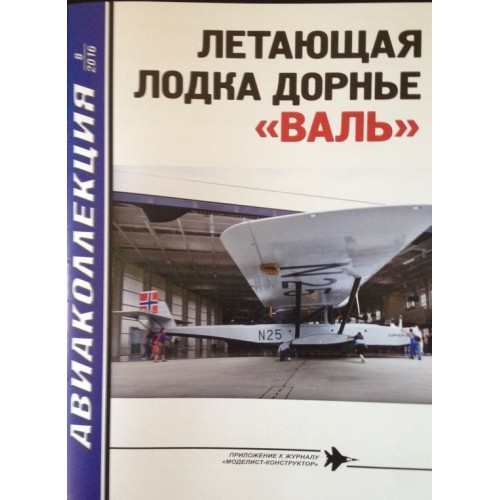AKL-201608 AviaCollection / AviaKollektsia series 08/2016: Dornier Do J Wal / Do-16 Twin-Engine German Flying Boat of the 1920s. Photos, schemes, colour pictures. 32 pages, soft cover, text in Russian.
CREATING A PLANE
In 1910, engineer K. Dornier joined the Luftshiffbau Zeppelin firm. The industrious and knowledgeable specialist quickly showed himself in a new place, and in 1913 Count Zeppelin already entrusted him with the preparation of a draft design of an airship for a transatlantic flight. For this purpose, a special department "Before" was formed, but the First World War interrupted the work. The firm has completely reoriented itself to military orders. Having engaged, in addition to airship construction, with heavy aircraft for the fleet, "Luftshiffbau Zeppelin" created a department for the construction of flying boats "Shipyard Zeemos" (later "Zeppelin Werke - Lindau"), which united the design office and the experimental plant. Dornier became its leader.
In 1915 he built his first airplane, the large biplane Rs I. This flying boat had three Maybach engines with 240 hp each. with push screws. The design of the Rs I was distinguished by an all-metal frame with a wide use of light alloys and a unit that made it possible to change the wing angle in flight. But Dornier did not have to see his first aircraft in flight - on December 21, 1915, before the start of tests, it was crashed in a parking lot by a storm.
The first design was followed by the second - Rs II, one and a half-glider with a very short lower wing, and it was not connected by the struts with the upper one. From the Rs I, the new flying boat inherited the upper wing turning mechanism, but now all three engines were located in the fuselage. The pushing screws were driven by a system of elongated shafts and gears. The tail unit had a complex box-shaped structure. The first flight took place on June 13, 1916. During the tests, the overly complicated plumage and placement of motors inside the boat were gradually abandoned.
The engines, of which there were four, were located in two tandems under the upper wing. Although the plane flew quite successfully, it did not go into mass production.
The next aircraft, the Rs III, was a monoplane of a very complex design. She also had an all-metal frame made of duralumin and steel with a linen covering. On a wide and short boat, a bulky truss was located on top, holding a long wing. Above it along the axis was located a rearward tail boom.
The wing was additionally braced with cables going to the boat and the tail boom. Four motors in two tandem installations were placed between the boat and the wing. The Rs III, which took off for the first time on November 4, 1917, successfully passed the entire test program at the plant and at the naval aviation base in Warnemünde, but, like its predecessors, it was not serially built.
The Rs IV retained much in common with the Rs III, but the pilot's cabin was moved from the boat to an elongated tail boom that turned into a real fuselage. This brought the aircraft closer to the float seaplane.
However, the most important feature is the so-called "gills" - the side projections of the boat in the form of a very short wing of a thick profile. They significantly increased the stability of the aircraft on the water, making it possible to dispense with supporting floats, and increased lift during the takeoff run. Subsequently, "gills" not only became a characteristic feature of all Dornier flying boats, but were also used by other designers.
The Rs IV took off in October 1918. After the surrender of Germany, the aircraft was converted into a six-passenger passenger aircraft, but this did not help - at the request of the Entente representatives, it was destroyed. Thus, all the aircraft of the Rs family remained only more or less successful samples, the experience of working on which contributed to the development of new Gs flying boats.
The design of the first of them, the Gs I, began in August 1918. Initially, it was created as a long-range reconnaissance and bomber, but the end of hostilities forced adjustments to be made; a closed cabin for six passengers was placed in the bow of the boat. The convex cockpit gave the aircraft the appearance of a sort of "tadpole". The general layout of the Gs I was already strongly reminiscent of the future "Val". It had a strut-braced parasol monoplane, an all-metal boat with "gills" and a motor-unit over the wing with two 270 hp Maybach IVa engines, one of which was supplied with a pulling propeller and the other with a pushing propeller. Significant differences were reduced to a box-type tail unit and a drop-shaped cockpit. The new machine entered trials on July 31, 1919. Due to restrictions imposed by the Entente controllers, most of the flights took place on the Swiss side of Lake Constance under the Ad Astra Aero flag. The boat was also registered in Switzerland. The plane was clearly successful: the maximum speed reached 170 km / h, and the service ceiling was 4250 m. The tests were carried out for three months, but the Ad Astra did not buy the seaplane. Potential customers from Sweden and the Netherlands became interested in a promising machine, but it also fell into the field of vision of the British and French intelligence services. After a demonstration flight near Amsterdam, the Allies demanded that the plane be destroyed. The crew in April 1920 sunk it in the Baltic Sea near Kiel. The tests lasted for three months, but the Ad Astra did not buy the seaplane. Potential customers from Sweden and the Netherlands became interested in a promising machine, but it also fell into the field of view of the British and French intelligence services. After a demonstration flight near Amsterdam, the Allies demanded that the plane be destroyed. The crew in April 1920 sunk it in the Baltic Sea near Kiel. The tests lasted for three months, but Ad Astra did not buy the seaplane. Potential customers from Sweden and the Netherlands became interested in a promising machine, but it also fell into the field of view of the British and French intelligence services. After a demonstration flight near Amsterdam, the Allies demanded that the plane be destroyed. The crew in April 1920 sunk it in the Baltic Sea near Kiel.
By this time Dornier had prepared a draft Gs II. Work on it was completed after the defeat of Germany, in 1919, so the alphanumeric designation according to military standards quickly disappeared, and only the name "Val" ("Kit") remained. Later, to distinguish this type from subsequent versions, it became call "Val-19".
The boat has slightly increased in size. The wing, rectangular in plan, also slightly enlarged in comparison with the Gs I, had a span of 22.5 m. The basis of its power set was two steel spars. They were connected by spacer trusses made of profiles, creating a torsion box. Its rigidity was increased by internal braces. Duralumin truss ribs were made from profiles. Almost the entire wing was covered with canvas, only a strip near the engine nacelle, about one meter wide, was sheathed with duralumin sheet. The wing was connected to the boat and "gills" by struts and struts.
The plumage has been greatly simplified compared to the previous machine. A rectangular stabilizer was hung on a single keel, supported by paired struts. The angle of installation of the stabilizer could vary within small limits. All plumage was covered with canvas.
Initially, the Gs II was going to be equipped with two 270 hp Maybach IV engines, but the adopted nacelle layout made it quite easy to change them to any other suitable power. The engines were again arranged in tandem.
Initially, no weapons were envisaged, but the Val could be used as a long-range naval reconnaissance aircraft.
First, they made a wooden model, and from the middle of 1920 they began to build two prototypes of the Gs II, but they were never finished - again the Entente controllers interfered.
In accordance with the Versailles agreements, Germany was banned from manufacturing not only military aircraft, but also those categories of civilian vehicles that could be adapted for military purposes. Heavy seaplanes are also on the banned list. Large German aviation enterprises began to look for workarounds, creating foreign branches. Dornier, who renamed the company to Dornier Metalbauten, chose Italy, where the sea does not freeze all year round. In the town of Marina di Pisa, on the territory of the former Gagnelli shipyard, the Constructionsi Meccanice Aeronautic di Pisa plant appeared. Italian partners provided money, and Dornier provided patents, the necessary documentation and fifty specialists.
At this enterprise, in July 1922, they began to build the first copy of the aircraft, which actually repeated the Gs II and was again named "Val". To distinguish it from the previous version, it was called "Val-22". The car was assembled in a military version with Hispano-Suiza 42 engines of 300 hp, which were then produced in Italy under license. The motors were liquid-cooled; a common water radiator was installed above the engine nacelle. Provided for the placement of two machine gun turrets: in the bow of the boat and behind the wing. The vehicle was ready on October 30, 1922; on November 6, it first took off under the control of W. Niemeyer.
AKL-201608 AviaKollektsia 8 2016: Dornier Do J Wal / Do-16 Twin-Engine German Flying Boat of the 1920s
- Brand: AviaCollection / AviaKollektsia
- Product Code: AKL-201608 In Stock
-
$3.90
Available Options
Look at these products too:
AKL-201707 AviaCollection 2017/7 Mil Mi-4 Hound Military and Civil Transport Helicopter
AKL-201707 AviaCollection 2017/7 Mil Mi-4 Hound Military and Civil Transport Helicopter. Photos, sch..
$3.90
Tags: aviation









